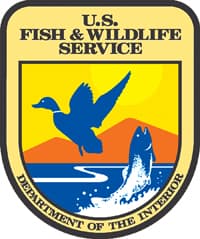Rice Receives National Fish Passage Award
OutdoorHub 02.07.14

On January 21, 2014, Bill Rice, P.E., received the 2013 National Fish Passage Program Field Biologist of the Year award in an all-employees ceremony held at the Alaska Regional Office of the U.S. Fish and Wildlife Service (Service). This national award is given each year to one Service employee in recognition of their exceptional contributions to the mission and objectives of the Service’s National Fish Passage Program. Alaska Regional Director, Geoff Haskett, presented the award on behalf of David Hoskins, Assistant Director of Fisheries and Aquatic Conservation for the Service.
“Bill’s work helps support what all Alaskans love to do most–fish! We are proud of Bill’s accomplishments, as well as our other staff, the Alaska Department of Fish and Game, and other local partners involved with fish passage projects”, said Geoff Haskett.
The National Fish Passage Program provides funding and technical assistance in all 50 states to reconnect aquatic habitat by eliminating or bypassing barriers to fish passage. Nationally, habitat fragmentation and loss are primary causes of the decline of freshwater and anadromous fish. Seemingly innocuous culverts that channel streams under roads are a major culprit. Most of the traditional round culverts, typically undersized relative to a stream’s width and placed at or above grade, impede fish movement. In southcentral Alaska’s fast-developing Matanuska-Susitna Borough, approximately 70% of the 567 culverts installed in fish-bearing streams at road-stream crossings evaluated by the Alaska Department of Fish and Game prevent salmon from reaching spawning and nursery habitats. Undersized culverts typically do not accommodate high water flows during heavy rains and other storm events, resulting in property loss and costly repair of damaged roads and other infrastructure.
One of only seven fish passage engineers in the entire Service, Bill has a rare combination of hydrologic, engineering, and interpersonal skills that he uses to build lasting partnerships that are improving fish passage in Alaska. For over a decade, he has worked collaboratively with Alaska communities and other partners to design and construct road-stream crossings that mimic the natural stream conditions and are fish-friendly for weak-swimmers like juvenile coho salmon. These fish-friendly crossings also reduce the risk of flood damage, support construction jobs, and help sustain the economic benefits associated with fishing and other recreation.
Bill is the Engineer of Record for over 60 fish passage improvement projects in Alaska and was the primary technical reviewer for more than 100 projects. Community Public Works Department officials regularly seek Bill’s fish passage technical expertise and, thanks in part to his input, some of these communities have now adopted road-stream crossing design standards that will help address flooding and fish passage requirements upfront, thereby, avoiding expensive restoration projects and flood damage.
Bill’s expertise is also exported to other parts of the Nation. He just returned from special assignment in Colorado where he worked side-by-side with FEMA representatives, local and state officials and other Service staff to ensure that actions taken in response to recent major flood events in Colorado consider the needs of fish and wildlife, along with other community needs. Upon receiving the award Bill explained that, “working with local communities on projects that help sustain healthy salmon populations and also support community infrastructure needs is a very rewarding aspect of my job. Our work benefits both fish and people!”
View photos of Alaska fish passage projects on Flicker: http://goo.gl/qfhs3E – See more at: http://www.thefishingwire.com/story/310699#sthash.D8534E8U.dpuf

